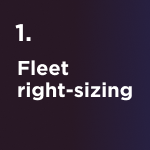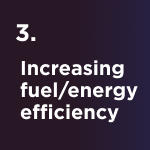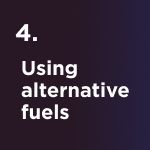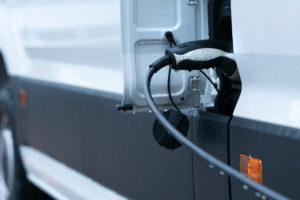Success in sustainable fleet operation is the result of a well-considered, well-executed plan. But how can you plan when so much changes so quickly and so often?
Currently, every fleet manager is facing the effects of geopolitical uncertainty, surging energy prices, growing congestion and ongoing supply chain shortages. Compounding these already challenging issues is the need to meet national targets for reducing greenhouse gas (GHG) emissions. Many fleets are introducing vehicles with zero-emission, alternative drive trains, which is all good, but is it enough?
Addressing sustainability is one thing, “being” sustainable is quite another. It’s relatively straightforward to introduce electric vehicles into the fleet to meet government mandated climate goals. But ensuring sustainability for your business and the planet as well as employees and customers at an operational level is a whole other challenge.
This blog post will bring together the views and information from companies, organizations and figureheads in the automotive, transport and mobility sectors to paint a picture of what fleet sustainability really means and how to “be” it, not just “do” it.
Defining sustainability
According to global telematics and fleet management data provider Geotab, fleet sustainability is:
“A continual process of evaluating the environmental and social impacts of the fleet, identifying improvements, implementing change, and measuring success – then starting the whole process again.”
We would add to that:
Sustainability includes making sure your business or organization is robust and resilient enough to continue supporting its stakeholders into the foreseeable future in an environmentally conscious and supportive way. That includes employees, customers, community, investors, shareholders, suppliers and any other party that relies upon its successes. Yes, an ideal sustainable fleet is electric, but few, if any, are 100% electrified today. Until EV transition matures, setting strategies for mixed (EV & ICE) fleets is both a smart and realistic road to take.
The full scope of this goes way beyond this blog post so we’ll focus on fleet operation while keeping in mind its place in the bigger picture.
Setting strategies for fleet sustainability
Central to any strategy is the principle that you cannot manage what you don’t measure. In terms of sustainable fleet management, this means implementing ongoing monitoring and setting targets according to business objectives, and the need for continuous improvement. Ideally, adopting EV planning, fleet charging & management software tools will do a lot of the otherwise complex work for you — especially if you want to start electrifying sustainably.
Here are a few smart strategies worth thinking about…
- The adoption of fuel-efficient and hybrid/electrical or low carbon fuel vehicles into the fleet where appropriate.
- Right-sizing your fleet for optimum utilisation and maximum operation.
- The application of optimized route planning.
- Training drivers in fuel-efficient driving.
- Proper fuel management.
- Predictive maintenance.
- Vehicle pooling or car sharing schemes.
- Implementing a mobility policy as an alternative to company car schemes.
Before you embark on your fleet electrification journey, a crucial step is to have clear operational and financial strategies in place. Transitioning to electric vehicles will involve considerable capital outlay, not just in terms of purchasing or leasing, but in terms of establishing a charging strategy and infrastructure. It’s important to know when (and if) EVs are the right choice for your operation. Business strategy (and good electrification planning) should dictate which vehicles are replaced with EVs.
We understand how tempting it can be (we’re all human, right?) to get things done quickly and tick that box — especially when there is so much to do in such a short time. But transitioning to EVs without a clear strategy would be akin to driving blindfolded!
In other words, the outcome could be messy and unsustainable!
Assessing strategies for fleet sustainability
Transport demand management and your EV transition potential
The aim is to clearly assess your transport needs and evaluate your current fleet’s status. This also helps you work out if you can reduce mileage across the organization in the short-term and thus reduce fuel consumption, mileage costs, emissions and maybe even fleet size. Key questions to assess: Are all trips necessary? Can they be combined? Are we using optimum routes?
Switch to cleaner fuels
Not all the vehicles in your fleet will be suitable for replacement with EVs so if you have ICE vehicles, make sure they are the smallest, lightest and most energy efficient for the job at hand. You could also consider adapting many of your vehicles to run on cleaner fuels such as biodiesel or hydrogen.
One overarching value of PANION software is that it shrinks the legwork involved in selecting the right EV. It brings the entire process together — plans EV transition with recommendations based on your fleet requirements and optimizes charging operations for a clear path to sustainable fleet management.
Sustainable vehicle use
The way in which vehicles are driven and maintained has a huge bearing on their fuel or energy efficiency and long-term sustainability. Educate your drivers on how to drive efficiently or even try methods such as gamification to motivate them to follow the guidance. Predictive and planned, rather than reactive maintenance, will help keep vehicles in the best condition and this in turn will optimize fuel efficiency and reduce wear & tear, especially on tires.
The 4 core principles to sustainable fleet operation
Parallel to what’s already been outlined, the National Renewable Energy Laboratory (NREL) states the four core principles of sustainable fleet management as:




1. The core principle of fleet right-sizing
This is all about securing the optimum number of vehicles for the business at hand and getting the best out of them — call it “sweating the vehicle asset” if you like. For this it’s essential to track and analyze information, such as:
- User-to-vehicle ratio.
- Mileage of each vehicle.
- Hours of usage, cross-referenced with mileage.
- Vehicle importance.
- Downtime of each vehicle on a granular level.
2. The core principle of minimizing distance traveled
This is done by improving scheduling and route management. Not only will this minimize environmental impact, it will also help reduce fleet costs. Tracking vehicle idling can also help improve route optimization. Utilizing software that uses telematics data and analyzes fleet movements helps here, with several other advantages besides.
3. The core principle of increasing fuel/energy efficiency
As already outlined, driver behaviors greatly influence fuel or energy efficiency. Additional data to be measured here can include:
- Tire pressure.
- Aggressive driving, such as irregular acceleration, hard braking and excessive idling.
- Tracking which vehicles are the least efficient and earmarking them for possible replacement with EVs.
4. The core principle of using alternative fuels
Alternative fuels don’t just have to mean switching to EVs — though obviously the most sustainable choice. Alternatives can include biodiesel, renewable diesel, ethanol and other flex-fuels, hybrid and hydrogen. Your plan should include assessing viability for each alternative and measuring the impact it could have on the fleet and on your drivers.
It’s important to ensure that drivers can refuel or charge when out and about without having to drive too far out of their way. A fuel card that includes electrical energy & alternative fuels and that is brand agnostic is the best option as it can be used anywhere there is a charge point or alternative refueling station. Coaching drivers to be more fuel efficient will help reduce fuel or energy consumption, lower costs and reduce driver stress.
Consolidating the fleet variables
Keeping up business sustainability, while planning for future fleet sustainability & net-zero can be a highly complicated endeavor. These days, fleets operate a variety of sizes, powertrains, brands and models of vehicle, which adds another layer of complication — from initial procurement to vehicle remarketing. Analyzing current fleets and the respective future charging needs reveals valuable data from which to move forward from.
So, how else do you “be” sustainable in fleet management?
Start by informing yourself about the software to accelerate electrification planning with PANION Transition. Part of the strategy, even for mixed fleets, is anticipating charging infrastructure needs — that’s where PANION Charging comes in.
Sounds like a win!




